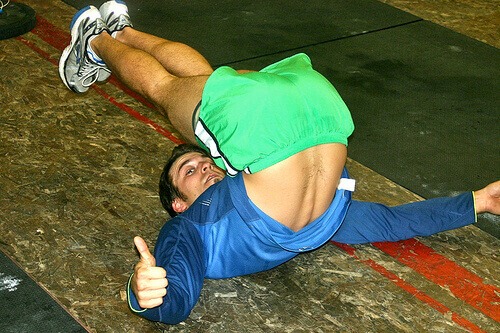Bacon Fried “Rice”
Sunday, January 22, 2012
Mobility:
Ankle mobility with band, 1 minute each side
Samson stretch, 1 minute each side
Warm-up:
2 rounds of:
10 Good mornings w/ bar
Skip rope 100 meters
Skip 100 meters (no jump rope)
10 Bounding box jumps
Skill:
Triple unders! Focus on tucking the knees hard and turning those wrists fast! Have fun!
Workout:
Run 5K (click here for route)
Cool down:
3 Rounds not for time:
15 Ghd sit-ups
15 Back extensions
15 light kettlebell swings
….oh yea!
I was approached on two separate occasions this week in the gym on my opinion of cholesterol as it relates to our pro stance of good fat intake as part of a balanced diet; is there such thing as eating too much cholesterol? Luckily, I had just read the chapter on Fats in Robb Wolf’s The Paleo Solution and felt that this would be good time to share with you all some nerdilicious nutrition science.
I was taken aback as to how to properly answer the question without first outlining the exact function of cholesterol and its important role it plays as energy in making Vitamin D, certain sex hormones, build/repair cell walls (remember this!), and making bile salts to break down other fats in the stomach. Cholesterol is produced in the liver; our livers produce about 1000 mg day. Of course, cholesterol is also found in animal based fats, eggs and dairy. Our body is smart enough is down regulate our own production if we consume more than our necessary 1000mg day, and as well, will up-regulate cholesterol production if we are not getting enough in our diet.
Once cholesterol is produced in the liver it needs to enter the blood stream to get to the sight receptors of cells that need repair, but since cholesterol is not soluble in blood it needs to bind with a protein (readily available in the liver as well) to “hitch a ride;” this new bond is now called a lipoprotein. There are 5 types of Lipoproteins, but only 2 concerns us at this time: Low-Density Lipoproteins (LDL) and High Density Lipoproteins (HDL). There are 2 types of LDLs: one that is large and puffy, dropping it’s cholesterol contents into cells that need repair (which is GREAT! You just did a killer WOD and your muscles are sore and need cholesterol as the energy for the cell to repair/replicate); the other is small and dense that have the tendency to get lodged into the lining in our arterial walls- NOT GOOD. These small, dense LDLs are born from a high carbohydrate diet; please take the time review with Crossfit Headmaster Nerd Zeb on Hyperinsulinemia as caused by the Western diet.
Let’s say you took 2 days rest and your body feels good and fresh, the cholesterol (as a lipoprotein) did its job to repair your sore muscles. There is no need to send more cholesterol to any particular receptor sites (for now, anyways) so where does that Low Density lipoprotein go? This is where his buddy High Density Lipoproteins comes into the picture. HDL sole purpose is to transport excess cholesterol back to the liver so it can be paired up once again with a protein to take it to a receptor site that need repair (cause you just did Filthy Fifty and are sore!) and the cycle starts all over again.
Studies have shown that chronically elevated insulin levels have a direct correlation to higher production of the small, dense LDLs as well as promote high blood pressure and inflammation. Therefore I would be more prone to advise on regulating the consumption of high-glycemic grains and fruit sugars to further reduce the production of small, dense LDLs which causes the most damage to arterial wall linings. I would then proceed to suggest that one increase their opportunity to produce more HDLs, the body’s natural regulator of excess cholesterol in the blood stream, by incorporating foods rich in Omega-3: Wild Alaskan Salmon, Sardines, Anchovies, Mackerel, Herring, Trout, Grass fed Beef, and Omega 3 enriched eggs. As full time Crossfit athletes, I definitely recommend taking a supplement of fish oil to ensure that you are meeting the daily recommended amount of EPA/DHA.
Here is a recipe I tested out on Patrick and Kamran this week and both gents say it turned out delicious.
BACON FRIED “RICE”
1 HEAD CAULIFLOWER
4 CLOVES GARLIC, MINCED
2 GREEN ONION, minced
6 SLICES BACON, CUT INTO SMALL PEICES
4TBS COCONUT AMINOS
3 EGGS, BEATEN
1. Cut cauliflower florettes off the stem. Using a blender or food processor, “pulse” on high 4 florettes at a time. The texture should be fine, and granulated like rice.
2. Render bacon in heavy bottom pan (cast iron, maybe:) until crisp. Remove bacon from pan, leaving the drippings.
3. On medium heat, add the minced garlic and green onion. Once fragrant, 15 seconds, add the cauliflower. Saute for about 10 mins, or until the cauliflower starts to brown and cook all the way through.
4. Push cauliflower to the sides of the pan and create a well in the center. Throw in the beaten eggs. Stir until eggs are cooked and “set.” Fold in the cauliflower in the center. Splash in the coconut aminos. Toss in bacon.
5. Garnish with chopped parsley or cilantro!
















